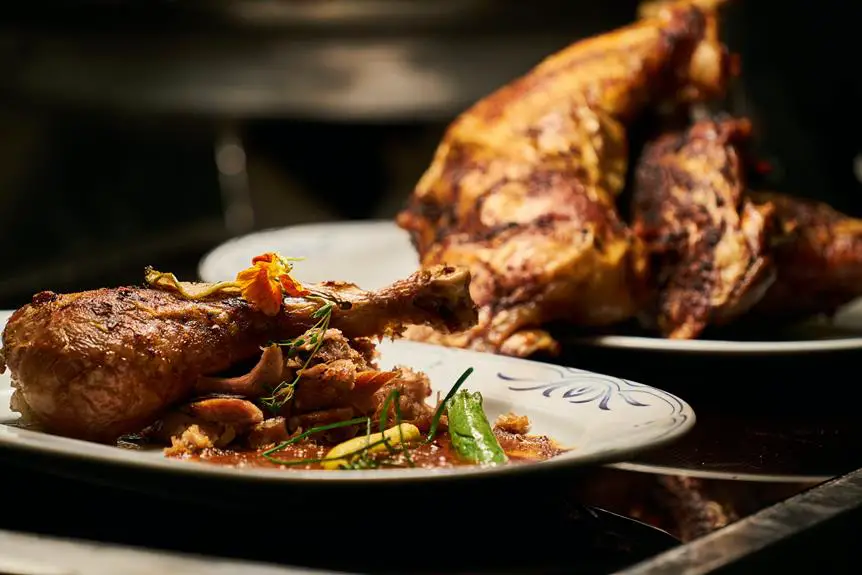When it comes to cooking chicken, you might see the terms “roasted” and “rotisserie” used interchangeably. What is the difference between roasted and rotisserie? While both methods utilize dry heat, their preparation methods differ significantly. Roasted chickens are cooked in a traditional oven at high heat, which can sometimes lead to uneven browning. Rotisserie chickens, on the other hand, are cooked on a rotating spit, ensuring all sides of the bird are exposed to the heat for even cooking and a deliciously crispy skin.
Differences in Cooking Methods
When it comes to cooking a chicken, the methods of roasting and rotisserie cooking offer distinct approaches that lead to varying results. Understanding these differences is key to choosing the method that best suits your culinary goals. Let’s delve into the specific ways these two methods work:
- Roasting involves placing a chicken in an oven, typically at a high temperature, and allowing it to cook until it reaches the desired internal temperature. The heat radiates from all sides of the oven, surrounding the chicken. While this method is relatively simple and often produces a flavorful result, it can lead to uneven browning.
- Rotisserie cooking, on the other hand, involves mounting a chicken onto a rotating spit, which is then placed in an oven or over an open fire. As the spit rotates, the chicken is exposed to the heat from all sides, ensuring even browning and a crispy skin. This constant motion also allows for the fat to render and baste the meat, further enhancing its flavor and tenderness.
What is the Difference in Equipment and Cooking Technique?
While both roasting and rotisserie cooking involve dry heat, the equipment and cooking techniques differ significantly.
- Roasting typically utilizes a conventional oven, where the food is placed on a baking sheet or in a roasting pan.
- Rotisserie cooking, on the other hand, requires a rotisserie oven or a rotisserie attachment for your oven. This specialized equipment features a rotating spit that holds the food, allowing it to cook evenly while rotating.
The rotation in rotisserie cooking is crucial, as it ensures that all sides of the food are exposed to the heat, resulting in more consistent cooking and a crispy exterior.
What is the Difference Between Roasted and Rotisserie: Contrasting Flavors and Textures
The cooking methods of roasting and rotisserie lead to distinct flavor profiles and textures in the final product. Roasting, with its static placement in the oven, can result in uneven browning and drier meat, especially in larger cuts. The heat concentrates on the top and sides, leaving the bottom less cooked. However, the concentrated heat can create a crispier skin and deeper flavors. In contrast, rotisserie cooking, with its rotating motion, ensures even browning and moisture retention. The constant movement allows for more even heat distribution, resulting in a succulent and juicy chicken with a crispy, flavorful skin all around.
| Method | Flavor & Texture | Pros | Cons |
|---|---|---|---|
| Roasting | Drier meat, especially in larger cuts. Uneven browning. Crispy skin. Deeper flavors. | Crispier skin, deeper flavors | Uneven browning, drier meat |
| Rotisserie Cooking | Even browning and moisture retention. Succulent and juicy chicken with a crispy, flavorful skin. | Even browning, moisture retention, succulent and juicy chicken | None |
What Distinguishes Roasted and Rotisserie Chicken?
Understanding the differences between roasted and rotisserie chicken can elevate your culinary skills and transform your dining experience. While both techniques utilize dry heat, their distinct approaches result in noticeable variations in flavor, texture, and overall presentation. Roasting, a more traditional method, involves placing the chicken in an oven, often with a combination of herbs and spices for added flavor. While simple to execute, roasting can sometimes lead to uneven browning due to the static nature of the cooking process. In contrast, rotisserie cooking employs a rotating spit, ensuring that the chicken is exposed to heat from all sides, resulting in even browning and a crispy skin. The constant motion of the spit also enhances moisture retention, creating a juicy, flavorful chicken.
What is the difference between roasted and rotisserie? Conclusion
The question “What is the difference between roasted and rotisserie?” is really about more than just cooking methods. It’s about understanding how these methods impact the final product, both in terms of flavor and texture. Roasting offers a simple and straightforward approach, while rotisserie delivers a more refined and even cooking experience. Ultimately, the best method depends on your individual preferences and desired outcome.
If you’re looking for a delicious and easy meal, roasting is a great option. If you want to impress your guests with a beautifully browned, juicy chicken, rotisserie cooking is the way to go. No matter which method you choose, make sure to enjoy the process and the delicious results!
What is the difference between roasted and rotisserie? Quick FAQ
What is the difference between roasting and rotisserie cooking in terms of equipment?
Roasting typically uses a conventional oven where the food is placed on a baking sheet or in a roasting pan. Rotisserie cooking, however, requires a rotisserie oven or a rotisserie attachment for your oven, featuring a rotating spit that holds the food for even cooking.
What is the difference between roasting and rotisserie cooking in terms of cooking technique?
Roasting involves placing a chicken in an oven at high heat and letting it cook until it reaches the desired temperature. Rotisserie cooking, on the other hand, involves mounting a chicken onto a rotating spit, exposing all sides to heat for even browning and a crispy skin.
What is the difference between roasting and rotisserie cooking in terms of flavor and texture?
Roasting can result in uneven browning and drier meat, especially in larger cuts. Rotisserie cooking, with its rotating motion, ensures even browning, moisture retention, and a succulent and juicy chicken with a crispy, flavorful skin all around.

